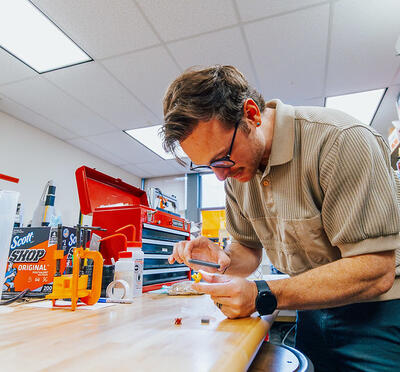A team led by University of Florida researchers recently tested a small fleet of large, robust, mobile weather stations at the OH Hinsdale Wave Research Lab at Oregon State University. The tests, which focused on whether the stations can survive extreme coastal storms, provided critical insights for optimizing the stations ahead of additional tests during the upcoming hurricane season and then full deployment in 2024.
“The Hinsdale Wave Research Laboratory is one of the few experimental facilities in the U.S. concentrated on the study of nearshore processes, such as storm surge, tsunamis, or hurricane waves at a relatively large-scale. The highly controllable wave conditions, staff experience, and advanced instrumentation at the lab allowed the execution of a thorough series of tests aimed at assessing the magnitude of the wave forces and determining how to reduce them according to the Sentinels design,” said Pedro Lomonaco, director of the OH Hinsdale Wave Research Lab.
Called “Sentinels,” these 10-meter-tall temporary structures can be installed directly on beaches in the littoral zone, secured by 6-meter-deep helical piles. Weather-hardened instrumentation will report on wind and wave loads, storm surge, coastal erosion and morphology changes, water quality, and other processes that occur during and after extreme coastal storms. The collocated and synchronized measurements are reported back to researchers in real-time over cellular networks.
A culminating effort
Natural-hazards watchers are familiar with the University of Florida’s extreme wind research efforts. Since the late 90s, UF researchers led by Kurt Gurley and Forrest Masters have deployed mobile weather stations in landfalling hurricanes as part of the Florida Coastal Monitoring Program. UF researchers erect the FCMP stations in strategic locations in the path of the hurricane to study surface-level wind fields.

(Right) Mark I Sentinel design (Image: Brian Phillips).
The Sentinels are a natural progression of that work, filling in the observational gap in the near shore region under combined hazards. Sentinels will support research in characterizing wind, storm surge, and wave impacts to civil and coastal infrastructure, predicting impacts to the nearshore water-land system, water quality monitoring during tropical cyclones and severe storms, and improving surface wind intensity estimates (e.g., numerical weather prediction and remote sensing). In 2021, Masters and his team successfully field-tested a prototype station, the Sentinel Mark I.
Based on early field tests of the Mark I Sentinel in 2022, a team led by UF researcher Brian Phillips landed an NSF Major Research Instrumentation (MRI) award to design a fleet of Mark II Sentinels as a shared-use resource. Design of these structures is underway.
Wave lab experiments
In 2023, for the MRI project design task, the team conducted experiments at the OH Hinsdale Wave Research Lab at Oregon State University, a facility in the NSF-funded Natural Hazards Engineering Research Infrastructure. OSU’s Directional Wave Basin is a reinforced-concrete reservoir about the size of an Olympic swimming pool. The DWB wavemaker can generate repeatable regular, irregular, tsunami and user-defined waves from varying directionality.
“Using the OSU facility, we can simulate dynamic breaking wave loads on the Sentinel,” said Phillips, who served as the project’s PI. “Experiments in the DWB are helping us better quantify breaking-wave forces and understand what can be done to reduce them on the station. We are exploring how changes in the Sentinel system’s geometry and dynamics affect the wave loads.”
One goal is to optimize the Mark II design for weight. “If we can reduce the wave impact forces, we can in turn reduce the Sentinel’s structural weight — which will enable us to bring more Sentinels into the field on hurricane deployments. Additionally, installation will be quicker and require less equipment, allowing us to cover a greater swath of the coast prior to landfall,” Phillips explained.
During two rounds of testing, the team installed a 1:10 prototype in the wave basin. First, working with OSU, they tuned the DWB wavemaker to achieve a variety of wave loading conditions on the scaled version of the Sentinel. In round two, the team explored how changes to the Sentinel design, both in geometry and dynamics, affected the breaking wave loads.
Next phases
Phillips says the next step in the project is to work with the Mark I Sentinel during the 2023 hurricane season. The focus will be on installation, logistics, and instrumentation. Afterwards, the Mark II design will be finalized, bringing together the Mark I field studies, OSU experimental results, and engineering analysis and optimization. A prototype Mark II Sentinel will be deployed in the 2024 hurricane season followed by a full build for the following season.



